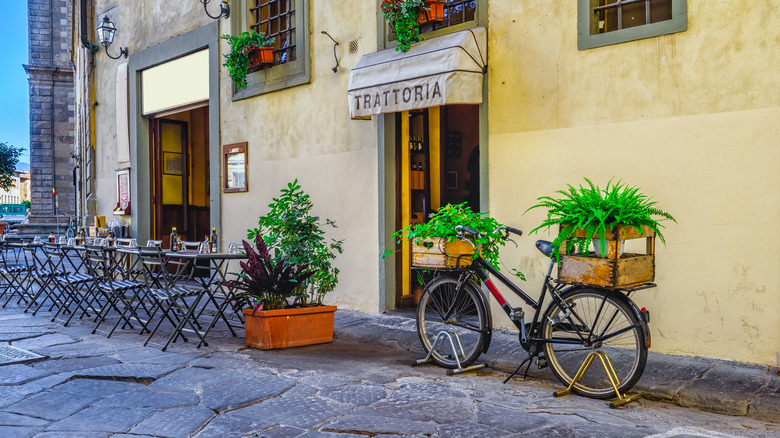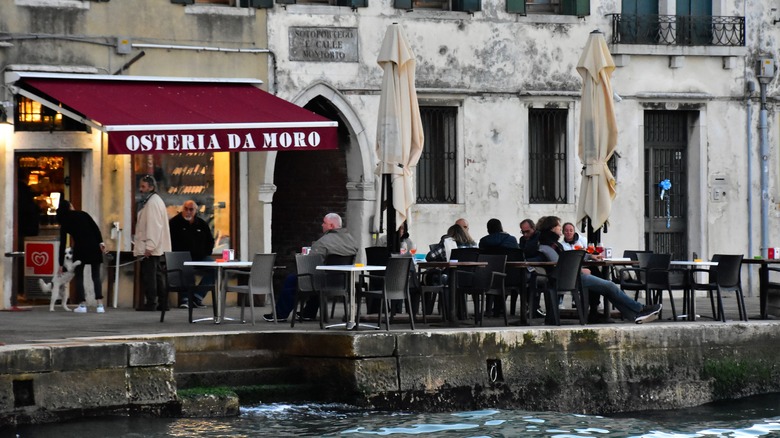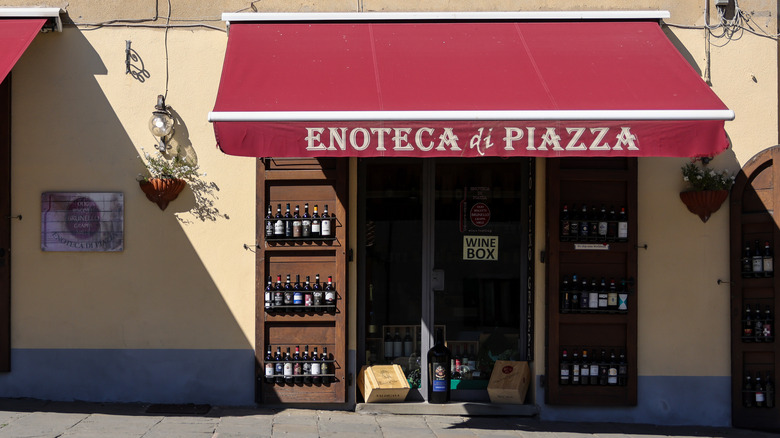Osteria, Enoteca, Trattoria: What Do Those Labels On Restaurants In Italy Really Mean?
If you've been to Italy, you may have noticed so many different kinds of eating and drinking establishments it made your head spin. Some have quite obvious meanings: a "pizzeria" clearly serves pizza, while a "gelateria" doles out cups and cones of the sweet frozen yumminess known as gelato.
But what about the "bars" that people frequent in the morning, for shots not of grappa but of espresso? And why are sit-down restaurants called so many different things when they appear so similar? We certainly don't want you to be stressed out by the prospect of eating and drinking in Italy because —mama mia — you might lose your appetite, and that would be sacrilegious. So here are some tips to help you navigate confusing terminology when traveling through this beautiful country, or bel paese, as locals would say.
First, let's talk about the difference between the most common types of sit-down restaurants: the ristorante, trattoria, and osteria. The ristorante tends to be the most formal of the three, the equivalent of Italian fine dining. These often have sommeliers on staff, full table service, multi-course meals, and prices to match. A trattoria, on the other hand, is less formal and less expensive than a ristorante and usually serves high-quality local dishes. The hearty dishes and warm and welcoming ambiance might make you feel like you're sitting in your nonna's (grandmother's) kitchen.
Italian restaurant typologies, continued
Meanwhile, an osteria is the least formal and expensive of the three kinds of sit-down restaurants, making them a great eatery option for those traveling Italy on a budget. For eons, Italians have come together at traditional osterie to eat and drink with their friends, like they have at the Osteria del Sole in Bologna, a ramshackle, cheerful hole in the wall that's been continuously operating since 1465. But now that you're clear on these typologies, be prepared to toss them out the window, as you'll encounter exceptions everywhere you go. For example, Osteria Francescana in Modena is an exquisite three-Michelin-star restaurant where a single meal can set you back $300. While both Osteria del Sole and Osteria Francescana are osterie (and in neighboring cities to boot), in terms of price and dining experience, they couldn't be farther apart.
Other kinds of Italian food establishments are a bit easier to recognize. A rosticceria sells roasted meat and other hot (and some cold) takeaway dishes, while a paninoteca sells panini, Italian sandwiches. In addition, a mercato is an indoor or outdoor market that sells a huge variety of foods, from fruit and veggies to eggs, bread, sweets, and just about anything else you can think of. Within a mercato, you can also find smaller markets selling specific products, like a pesceria, which sells fish (common if you're in a coastal area).
Italian drinking establishments
Now, onto the drinking establishment lexicon. If you've dipped even your small toe into Italy, you probably already know this. But just for the record, a bar in Italy is not the same as a bar in the U.S. or elsewhere. While some Italian bars do serve alcohol, they mainly sell caffè (coffee), pastries, and snacks, which you normally purchase and drink or eat while standing at the counter. Drinking coffee like a local at the neighborhood bar is not only affordable but also a fun way to immerse yourself in the local culture. Some bars stay open into the evening and host aperitivo, or happy hour, during which they'll serve appetizers, drinks, and the famous Aperol spritz. Note that aperitivo is the proper time/place for spritz if you want to avoid getting side-eyed by the locals.
So where, then, do Italians go to drink their wine and other spirits? Other than eating establishments, which we've already covered, wine lovers will head straight to the enoteca, which may also serve food but specializes in local wine, which, of course, varies from region to region. An enoteca in the enchanting, hilly destination of Conegliano Valdobbiadene may feature prosecco, whereas a Tuscan enoteca serves Chianti or wines from Montepulciano. If it's other spirits that they're after, Italians go to a birreria, a pub or brewery, for a cold Peroni, craft beer (yes, Italy has a craft beer scene), or cocktail.


